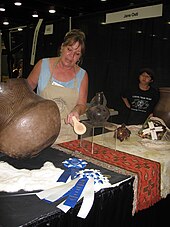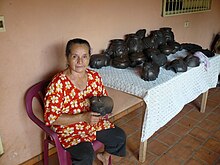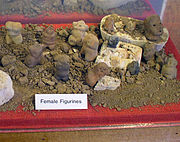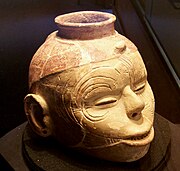Ceramics of Indigenous peoples of the Americas

Ceramics of Indigenous peoples of the Americas is an art form with at least a 7500-year history in
Due to their resilience, ceramics have been key to learning more about
Materials and techniques

The
While still green, pottery can be incised with designs. Cords, textiles, baskets, and corncobs have been rolled over wet clay, both as a decoration and to improve heat dispersion in cooking pots. Carved wood or ceramic stamping paddles are used throughout the
Before firing, ceramics can be burnished or polished to a fine sheen with a smooth instrument, usually a stone. Glazes are seldom used by indigenous American ceramic artists. Grease can be rubbed onto the pot as well.[2]
Prior to contact, pottery was usually open-air fired or pit fired; precontact Indigenous peoples of Mexico used kilns extensively. Today many Native American ceramic artists use kilns. In pit-firing, the pot is placed in a shallow pit dug into the earth along with other unfired pottery, covered with wood and brush, or dung, then set on fire whereupon it can harden at temperatures of 1400 degrees or more. Finally, the ceramics surface is often polished with smooth stones.
Tempers
Tempers are non-plastic materials added to clay to prevent shrinkage and cracking during drying and firing of vessels made from the clay.[6] Tempers may include:
- Bone;[7]
- Chaff;[7]
- Charcoal;[8]
- Wood ash (cariapé);[9]
- Grit;[6]
- Sand, crushed sandstone;[3]
- Crushed limestone;[10]
- Crushed igneous rocks, such as volcanic rock, feldspar, or mica;[9][11][12]
- Grog;[3]
- Plant fiber;[13]
- Mollusc shells, freshwater and marine (sometimes fossilized), crushed;[6][10]
- Freshwater Sponge spicules.[9][14][15]
Not all Indigenous American pottery requires added tempers; some
Ceramics are often used to identify
The choice of temper used in ceramics was constrained by what was available, but changes in the choice of temper can provide clues to influence and trade relations between groups. Shell-tempered ware was produced sporadically in various places across the eastern United States, but in the late
Origin and spread
The earliest ceramics known from the Americas have been found in the lower
Ceramics appeared next across northern South America and then down the western side of South America and northward through Mesoamerica. Ceramics of the Alaka culture in Guyana have been dated to 6,000 to 4,500 years ago.[25] Ceramics of the San Jacinto culture in Colombia have been dated to about 4530 BCE, and at Puerto Hormiga, also in Colombia, to about 3794 BCE. Ceramics appeared in the Valdivia culture in Ecuador around 3200 BCE, and in the Pandanche culture in Peru around 2460 BCE.[26]
The spread of ceramics in Mesoamerica came later. Ceramics from Monagrillo in Panama have been dated to around 2140 BCE, from Tronadora in Costa Rica to around 1890 BCE, and from Barra in the Soconusco of Chiapas to around 1900 BCE. Ceramics of the Purrón tradition in southcentral Mexico have been dated to around 1805 BCE, and from the Chajil tradition of northcentral Mexico, to around 1600 BCE.[26]
The appearance of ceramics in the
Cultural regions
North America
Arctic
Several
Eastern Woodlands
- archeological sitesin the American Midwest and Southeast.
- Mississippian culture pottery is the ceramic tradition of the Mississippian culture (800–1600 CE) found as artifacts in archaeological sites in the American Midwest and Southeast.
Southeastern Woodlands
Geological studies show that certain areas of the southeastern portion of North America are rich in kaolins and ball clays (Hosterman, USGS),[clarification needed] the types of plastic clays best suited for pottery. Clay beds which still produce ceramic clays are from primary and secondary deposits formed in the Late Paleocene and Early Miocene Epochs in formations that formed the Gulf Coastal Plain. According to all geological surveys the entire southeastern portion of the continent has abundant clay deposits, with the exception of all of south Florida and a portion of western central Florida (Calver) (Matson).[clarification needed]
Fiber-tempered ceramics associated with
Thoms Creek ceramics closely resembled Stallings ceramics, but used more sand and less fiber as temper than Stalling or Orange ware. Thoms Creek ceramics were largely contemporary with Stalling and Orange ceramics, although no Thoms Creek ceramics have been found that are as early as the earliest Stallings. Thoms Creek ceramics overlapped Stallings ceramics in northern Georgia and southern South Carolina, but were the dominant tradition north of the Santee River into North Carolina.[36]
The similarities of the Stallings series ceramics to the earlier Puerto Hormiga ceramics of Colombia, which were both associated with shell rings, and the presence of winds and ocean currents favoring journeys from South America to the Southeastern United States, led James A. Ford, among other archaeologists, to offer the hypothesis that the two areas had connections, and that the technology of fiber-tempered ceramics in the southeastern United States had been imported from Colombia. Other archaeologists have noted that there are no known archaeological sites between Colombia and Florida that are of a type or age consistent with such connections, and that the cultural traditions of the Southeastern United States show no significant changes associated with the appearance of ceramics, indicating that there was no migration or people, and no transfer of technology or other elements of culture, other than the appearance of ceramics.[37]
Later significant developments in ceramics in the Southeastern Woodlands included
- Swift Creek and Santa Rosa culture pottery post Deptford, northwest Florida, ceremonial decorative pottery, 1000 A.D.
- Glade and Belle Glade culture pottery fiber or sand-tempered crude pottery, south Florida to central Florida, 500 BCE until 1700 A.D., reference four periods I, II, III and IV
- Alachua culture pottery northeast, north central Florida, protohistoric period
- Plaquemine culture pottery, ceramics of the Natchez people, a historic tribe known also to be one of the last of the Plaquemine culture chiefdoms in southwestern Mississippi
- Fort Walton culture pottery distinctively Mississippi culture in Florida panhandle, developed out of the Weedon Island culture 1000 A.D.
-
Figurines from Poverty Point
-
Pot from Kolomoki Mounds
-
A human head effigy pot from the Mississippian culture
-
Natchez pots from the Fatherland site
-
Cherokee stamping paddles, used to imprint designs in pottery
Great Basin
Southwestern cultures (Oasisamerica)
Pueblo cultures


- Ancestral Pueblo
- Mimbres pottery
- San Ildefonso Pueblo, Acoma Pueblo and the Zuni. Noted individuals involved in Pueblo pottery include Nampeyo of the Hopi, and Maria and Julian Martinez of San Ildefonso Pueblo. In the early 1900s, Maria Martinez and her husband Julian rediscovered how to make the traditional Black-on Black pottery, for which San Ildefonso Pueblo would soon become widely known.
| Pottery style | Time period |
|---|---|
| Late Basketmaker II Era | 50 BCE – 450 CE |
| Basketmaker III Era | 450 CE – 700 CE |
Pueblo I Era |
700–900 |
Pueblo II Era |
900–1100 |
Pueblo III Era |
1100–1300 |
Pueblo IV Era |
1300–1600 |
| Historic | 1600–1880 |
| Modern | 1880–1950 |
| Contemporary | 1950–present[39] |
O'odham cultures
- Tohono O'odham, Akimel O'odham
Athabaskan
Southern Athabaskans include the
Other
- The Salado Polychrome.
- Casas Grandes
Mesoamerican pottery
- Barra/Mokaya (c. 1900 BCE)
- Tlatilco (c. 1500 BCE)
- Olmec(c. 1500–400 BCE)
- Teotihuacan (c. 300 BCE – 600 CE)
- Zapotec (c. 200–800 CE)
- Mixtec(c. 900 CE)
- Purépecha(c. 800–1300 CE)
- Maya ceramics (c. 317–1200 CE)
- Remojadas (c. 750 CE)
- Toltec / Mayan (c. 1200–1500 CE)
- Aztec(c. 1168–1519 CE)
- Coclé, Panama with the following periods: La Mula (c. 150 BCE – 300 CE), Tonosi (c. 300–550 CE), Cubita (c. 550–700 CE), and Gran Cocle (c. 1200–1500 CE).
- Classic Veracruz Culture (c. 100–1000 CE)
- Capacha (c. 1500 BCE to 1000 BCE)
- Western Mexico shaft tomb tradition (c. 300 BCE to 550 CE)
-
Aztec household pottery
-
Teotihuacan incense burner
-
A large figurine of a young chieftain, Classic Veracruz culture
-
Zapotec ceramic urn, 200 BCE-800 CE, British Museum
-
The "Acrobat", Tlatilco.
-
Toltec style orange-ware clay vessel
Circum-Caribbean
Antilles
Ceramics first appeared in the
Other ceramics styles are also known from the Antilles during this time period. Barrancoid trade wares, of a style that had developed in the Orinoco River valley around 1000 BC, have been found in the southernmost Antilles; Trinidad,
Colombia and Venezuela
Fiber-tempered ceramics associated with shell middens left by hunter-fisher-gatherers of the Early Northwest South American Literature appeared at sites such as Puerto Hormiga, Monsú, Puerto Chacho, and San Jacinto in Colombia by 3100 BCE. Fiber-tempered ceramics at Monsú have been dated to 5940 radiocarbon years before present. The fiber-tempered pottery at Puerto Hormiga was "crude", formed from a single lump of clay. The fiber-tempered pottery at San Jacinto is described as "well-made". Sand-tempered coiled ceramics have also been found at Puerto Horrible.[37][43][44]
La Chamba in the Tolima Department is known for its blackware. The women potters here also create brown and red ware.[46]
Andean region

In the Andes, great civilizations had been created and flourished for thousands of years during the Andean preceramic period. Yet the ceramics appear only during the Initial Period around 1800 BCE. Their main purpose may have been for boiling agricultural produce.[47]
The earliest ceramics in the Andean area have been radiocarbon dated to about 1800 BC, although according to John H. Rowe the date may go back even to 2100 BC. Early ceramics have been found on the central coast at the large settlement of Las Haldas, at Huarmey, as well as at some other sites in the Casma River region, and in Lima area.[48]
Chavín potters (900–200 BC) on the Peruvian coast created distinctive stirrup spout vessels, both incised and highly burnished. These thin-walled effigy pots were fashioned to resemble stylized humans, plants, and animals. Two substyles of Chavín stirrup spout pots include the thicker-walls, glossy-on-matte blackware Cupisnique style and red and black Santa Ana style, both featuring fanged heads.[49] Subsequent Andean cultures revived these ancient ceramics styles and imagery.[50]
Dominating Peru's north coast from 1–600 CE, the
The Tiwanaku and Wari cultures shared dominance of the Andes, roughly from 500 to 1000 BCE. The Tiwanaku civilizations originated in Lake Titicaca region of Bolivia, and a staff-bearing deity figured largely in their artwork.[55] Tiwanaku artists continued the tradition of naturalistic, ceramic portrait vessels.[56] The ubiquitous Wari ceramics carried over imagery from their textiles and metalwork, such as llama and alpaca imagery. Qunchupata in Peru was the epicenter of Wari ceramic production, featuring pit kilns and firing rooms. The stone floors of the firing rooms had rounded depressions for accommodating larger pots. Some Wari palaces had their own attached kilns. Broken potsherds were used as forms for building new pots and for scrapers. Evidence shows ceramics were often ritually destroyed.[57]
Four Andean civilizations flourished in Late Intermediate Period: the
The

| Andean cultural horizons | Time period | Cultures/sites |
|---|---|---|
| Lithic | 10,000–3,000 BCE | Guitarrero Cave |
Cotton Pre-Ceramic |
3000–1800 BCE | Norte Chico civilization, Huaca Prieta, Las Haldas
|
| Initial Period | 1800–800 BCE | Chinchorro, Las Haldas |
| Early Horizon | 800–200 BCE | Cupisnique, Paracas, Chavín, Pukará |
| Early Intermediate Period | 200 BCE–500 CE | |
| Middle Horizon | 500–900 CE | |
| Late Intermediate Period | 900–1400 CE | Inca
|
| Late Horizon | 1400–1534 | Inca[65] |
| Historical | 1534–1950 | Indigenous peoples of the Andes
|
| Contemporary | 1950–present | Indigenous peoples of the Andes
|
-
Recuay effigy of a feline attacking a warrior, Musée du Quai Branly, Paris
-
Anthropomorphic Wari polychrome pottery
-
Chancay female effigy bottle, ca. 1100–1400
-
Chimú stirrup spout vessel representing a fisherman on a caballito de totora, 1100–1400 CE
Gran Chaco

Tobatí, a city near Asunción, Paraguay, is renowned for its ceramics, including tiles and female effigy jars, known as Las gorgas. A reddish-brown slip, known as tapyta in Guaraní, is popular, with blackware being less common.[67] A local ceramic artist, Don Zenón Páez (b. 1927) became famous for his ceramic figures of saints.
Itá, Paraguay is another ceramic center, known for its whimsical, ceramic chickens.[68] Rosa Brítez (b. 1941) is a famous ceramic artist from Itá and has been recognized by UNESCO.
The Museo del Barro, "Museum of Clay," in Asunción features pottery from the Gran Chaco, from Pre-Columbian Guaraní to contemporary mestizo ceramics.[69]
Amazonia

The pottery tradition at
In regions of terra preta, or "black earth", of the Amazon rainforest, an abundance of potsherds were used to develop the soil and build mounds, which protected buildings and cemeteries from seasonal flooding.[72]
Women have traditionally been the ceramic artists in the Amazon. Female figures are common in anthropomorphic effigy vessels. Tangas are a unique Amazonian cultural item; they are triangular, concave ceramic pubic coverings held in place by strings, once worn by women of several Amazonian tribes. Today, they are still worn by girls during their puberty rites among Panoan-speaking peoples.[74]
Ceramics forms
See also
- List of indigenous ceramics artists in the Americas
- List of Native American ceramics artists in the United States
- Visual arts by indigenous peoples of the Americas
- Huaco (pottery)
- Mata Ortiz pottery
- Mexican ceramics
- Mimbres pottery
- Pit fired pottery
- Painting in the Americas before Colonization
- Pottery of the American Southwest
- Indigenous peoples of the Americas
- Black-on-black ware
- Pueblo pottery
Notes
- potsherds found at Rabbit Mount near the lower Savannah River in South Carolina have been dated to 4465 ± 95 and 4450 ± 150 radiocarbon years before present.[31]
References
- ^ a b Silverman & Isbell 2008, p. 365.
- ^ a b c "Through the Eyes of a Pot: How is Pueblo Pottery Made?". Lowell D. Holmes Museum of Anthropology. Archived from the original on 9 February 2012. Retrieved 2 November 2011.
- ^ ISBN 978-0-19-284218-3.
- ^ Cooper 2000, p. 186.
- ^ Stone-Miller 2002, pp. 69–70.
- ^ a b c "Ceramics". Mississippi Valley Archaeology Center – Technologies. University of Wisconsin – La Crosse. Archived from the original on 27 September 2011. Retrieved 4 November 2011.
- ^ ISSN 1461-9571.
- ^ Silverman & Isbell 2008, p. 439.
- ^ .
- ^ a b Weinstein & Dumas 2008, p. 203.
- ^ Silverman & Isbell 2008, p. 307.
- ^ Watters 1997, pp. 92–94.
- ^ Milanich 1994, p. 86.
- ^ Silverman & Isbell 2008, p. 369.
- ^ a b c "Pelotes Island Nature Preserve - Woodland Period - St. Johns Cultures - 500 BC to 1500 AD." Archived 12 November 2011 at the Wayback Machine Retrieved 5 November 2011
- ^ Whittlesey, Stephanie M. (2008). "Hohokam Ceramics, Hohokam Beliefs". In Fish, Suzanne K (ed.). The Hohokam Millennium. School for Advanced Research Press. pp. 65–73.
- ^ "Southeast Texas Archaeology". Houston Archaeological Society. Retrieved 6 November 2011.
- ^ Lopez, Adrienne; Fullen, Steve. "Examining Pottery with Scope-On-A-Rope" (PDF). Adventures in Archaeology. Louisiana State University Museum of Natural Science. Archived from the original (PDF) on 15 April 2012. Retrieved 5 November 2011.
- ^ Milanich 1994, pp. 86, 94.
- ISBN 978-0-9692568-0-9.
- ^ Weinstein & Dumas 2008, p. 202.
- ^ "Museum of Native American Artifacts-MISSISSIPPIAN PERIOD 900 AD - 1450 AD". Retrieved 18 July 2010.(registration required)
- ^ "Prehistoric Brazilian Cave Forces New Theories Of Early Human Life In The New World". EurekAlert!. Archived from the original on 18 April 2014. Retrieved 13 May 2021.
- S2CID 34969614 – via ResearchGate.
- ^ a b Roosevelt 1996, pp. 318–319.
- ^ a b c Clark & Gosser 1995, pp. 210–11.
- ISBN 0-8130-2808-6.)
{{cite book}}: CS1 maint: multiple names: authors list (link - ^ Savelle, James M. "Historic Inuit Pottery in the Eastern Canadian Arctic: Abstract." Polar Record. (1986), 23: pp. 319-322. (Retrieved 4 Nov 2011)
- ^ "Ceramics." Nunavut Arts and Crafts Association. (Retrieved 4 Nov 2011)
- ^ "Hopewell (archaeology)". Wisconsin Historical Society. Archived from the original on 9 November 2011. Retrieved 19 July 2010.
- ^ Saunders 2002, p. 19
- ^ Walthall 1980, pp. 78, 80, 82–83.
- ^ Milanich 1994, p. 94.
- ^ Walthall 1980, pp. 80, 83, 87.
- ISBN 978-0-8173-5085-7. Retrieved 19 November 2016.
- ISBN 978-0-8173-5127-4. Retrieved 19 November 2016.
- ^ a b Walthall 1980, pp. 82–83.
- ^ Beckman, Tad (1996). "Great Basin Material Cultures". Harvey Mudd College. Archived from the original on 7 October 2011. Retrieved 4 November 2011.
- ISBN 0-87358-656-5.[page needed]
- ^ Wilson 1997, p. 5.
- ^ Allaire 1997, pp. 22–24.
- ^ Righter 1997, pp. 72–74.
- ISBN 0-306-46259-1.
- ISBN 0-12-557180-1.
- ^ Davies & Fini 1995, p. 122.
- ^ Davies & Fini 1995, p. 123.
- ^ Stone-Miller 2002, p. 23.
- ^ The Initial Period. britannica.com
- ^ Stone-Miller 2002, pp. 45–6.
- ^ Stone-Miller 2002, p. 47.
- ^ Stone-Miller 2002, pp. 48–51.
- ^ Stone-Miller 2002, pp. 64–73.
- ^ Stone-Miller 2002, pp. 82–6.
- ^ Stone-Miller 2002, p. 106.
- ^ Stone-Miller 2002, p. 118.
- ^ Stone-Miller 2002, p. 136.
- ^ Stone-Miller 2002, pp. 149–152.
- ^ Stone-Miller 2002, pp. 153–4.
- ^ Stone-Miller 2002, p. 161.
- ^ Stone-Miller 2002, p. 174.
- ^ Stone-Miller 2002, p. 175.
- ^ Stone-Miller 2002, p. 179.
- ^ Stone-Miller 2002, p. 180.
- ^ Stone-Miller 2002, pp. 184, 214–5.
- ^ Stone-Miller 2002, pp. 7–8.
- ^ Escobar, Ticio. "Cerámica Popular Paraguaya." (in Spanish) Portal Guarani. (retrieved 10 Nov 2011)
- ^ Davies & Fini 1995, p. 127.
- ^ Davies & Fini 1995, p. 143.
- ^ "The Museo del Barro In Ansuncion Paraguay." Paraguay Travel Guide. (retrieved 21 Nov 2011)
- ^ Silverman & Isbell 2008, p. 207.
- ^ a b Silverman & Isbell 2008, p. 368.
- ^ a b "Marajó: Ancient Ceramics from the Mouth of the Amazon." (retrieved 9 Nov 2011)
- ^ Silverman & Isbell 2008, p. 366.
- ^ "Archaeology." Marajó. (retrieved 9 Nov 2011)
Bibliography
- Allaire, Louis (1997). "The Lesser Antilles before Columbus". In Samuel M. Wilson (ed.). The Indigenous People of the Caribbean. Gainesville, Florida: University Press of Florida. pp. 20–28. ISBN 0-8130-1531-6.
- Clark, John E.; Gosser, Dennis (1995). "Reinventing Mesoamerica's First Pottery" (PDF). In William K. Barnett; John W. Hoopes (eds.). The Emergence of Pottery: technology and innovation in ancient societies. Washington: Smithsonian Institution Press. pp. 209–219. ISBN 978-1-56098-516-7. Retrieved 19 November 2016.
- Cooper, Emmanuel (2000). Ten Thousand Years of Pottery. Philadelphia: University of Pennsylvania Press. ISBN 978-0-8122-3554-8.
- Josephy, Alvin M., Jr. The Indian Heritage of America. Boston: Mariner Books, 2001. ISBN 978-0-395-57320-4.
- Davies, Lucy; Fini, Mo (1995). Arts & crafts of South America. San Francisco: Chronicle Books. ISBN 0-8118-0837-8.
- ISBN 0-8130-1273-2.
- Righter, Elizabeth (1997). "The Ceramics, Art, and Material Culture of the Early Ceramic Period in the Caribbean Islands". In Samuel M. Wilson (ed.). The Indigenous People of the Caribbean. Gainesville, Florida: University Press of Florida. pp. 70–79. ISBN 0-8130-1531-6.
- Roosevelt, Anna C. (1996). "The Maritime, Highland, Forest Dynamic and the Origins of Complex Culture". In Frank Salomon; Stuart B. Schwartz (eds.). The Cambridge History of the Native Peoples of the Americas. Cambridge, England New York: Cambridge University Press. pp. 264–349. ISBN 978-0-521-63075-7.
- Saunders, Rebecca (2002). "The Fig Island Ring Complex (38CH42): Coastal Adaptation and the Question of Ring Function in the Late Archaic" (PDF). National Park Service. Archived from the original (PDF) on 14 July 2010. Retrieved 13 November 2011.
- Silverman, Helaine; Isbell, William (2008). Handbook of South American archaeology. New York: Springer. ISBN 978-0-387-75228-0. Retrieved 19 November 2016.
- Stone-Miller, Rebecca (2002). Art of the Andes: from Chavín to Inca. London: Thames & Hudson. ISBN 978-0-500-20363-7.
- Walthall, John A. (1980). Prehistoric Indians of the Southeast: Archaeology of Alabama and the Middle South. Tuscaloosa, Alabama: University of Alabama Press. ISBN 978-0-8173-0552-9. Retrieved 19 November 2016.
- Watters, David R. (1997). "Maritime Trade in the Prehistoric Eastern Caribbean". In Samuel M. Wilson (ed.). The Indigenous People of the Caribbean. Gainesville: University Press of Florida. pp. 88–99. ISBN 0-8130-1531-6.
- Weinstein, Richard A.; Dumas, Ashley A. (2008). "The Spread of Shell-Tempered Ceramics along the Northern Coast of the Gulf of Mexico" (PDF). Southeastern Archaeology. 27 (2). Maney Publishing: 202–221. Archived from the original (PDF) on 25 April 2012. Retrieved 5 November 2011.
- Wilson, Samuel M. (1997). "Introduction to the Study of the Indigenous People of the Caribbean". In Samuel M. Wilson (ed.). The Indigenous People of the Caribbean. Gainesville, Florida: University Press of Florida. pp. 1–8. ISBN 0-8130-1531-6.
- Hosterman, John W. (1984). "Ball Clays and Bentonite Deposits of the Coastal and Western Gulf of Mexico Coastal Plain, United States". Washington, D.C.: USGS Bulletin 1558-C.
- Calver, James L. (1949). "Florida Kaolins and Clays". Florida D.E.P., FLGS.
External links
- Pottery in the collection of the National Museum of the American Indian
- Mesoamerican Pottery Database, Foundation for the Advancement of Mesoamerican Studies
- The Amerind Foundation, extensive collection of North, Central and South American pottery
- Bandelier National Monument Virtual Museum Exhibit and Lesson Plans, National Park Service
- Chaco Culture National Historic Park Virtual Museum Exhibit, National Park Service
- Native paths: American Indian art from the collection of Charles and Valerie Diker, an exhibition catalog from The Metropolitan Museum of Art (fully available online as PDF), which contains a great deal of material on ceramics of indigenous peoples of the Americas
- Ancient Peruvian ceramics: the Nathan Cummings collection by Alan R. Sawyer, an exhibition catalog from The Metropolitan Museum of Art (fully available online as PDF), which contains material on ceramics of indigenous peoples of the Americas
- The responsive eye : Ralph T. Coe and the collecting of American Indian art, a 2003 exhibition catalog from The Metropolitan Museum of Art (fully available online as PDF)
- Ceramica de la Tierra at the American Museum of Ceramic Art
















